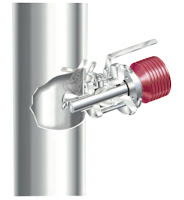Introduction

The first step in the beer brewing process is the preparation of malt grains. The extract received fromthe processing of this raw material is called wort. The second step is fermentation by yeast. The last steps are conditioning and final filtration. After filtration, the beer is ready for bottling.
Instrumentation and Installation
Vaisala K-PATENTS® Sanitary
Process Refractometer PR-43-A is used at many stages of the brewery process to determine in real-time and accurately the concentration of dissolved solids. The refractometer takes an optical measurement of the refractive index of a solution and its output can be calibrated in Plato, Brix, Balling, gravity or density, depending on the preference of the brewery.
The Sanitary Refractometer is available with 3-A Sanitary and EHEDG certifications and it withstands CIP/SIP cleaning and rinsing of the facilities.
1. Mash tank
Mashing is the process of mixing the crushed malt with very hot water. In this process, the malted grain breaks down to create enzymes, which become active when exposed to water at a specific temperature. These active enzymes convert the starches into sugars. The resultant sugary liquid is known as the wort. Mashing is a crucial step as it determines the final structure of the beer.
In the mashing stage, the refractometer is used to measure the concentration of the mash in water at the outlet pipe to maintain a consistent concentration. Automatic prism wash with steam or high-pressure hot water is recommended for this application.
2. Lauter Tun
Lauter tun is a vessel used to separate the extracted wort from the spent grain. The solids in the lauter tun are rinsed with water to separate the clear liquid wort from the solids. The liquid concentration gradually decreases during the rinsing.
At the lauter tun the refractometer’s output signal is used to detect the shut-off point for rinsing, thus preventing excessive use of water. Automatic prism wash with steam or high-pressure water is recommended for this application.
3. Wort Boiler (Brew Kettle)
In the wort boiler the wort is pasteurized, and its flavor is adjusted by the addition of hops (or other flavors such as ginger or molasses). The brew is boiled until a certain strength or gravity is achieved. This step is essential for the quality of the final beer.
The refractometer is installed directly on the wort boiler to measure the wort strength/gravity. It provides an instant feedback when the wort has reached its required strength. No by-pass arrangements are required. The purpose is to eliminate sampling, optimize the boiling time, and to improve beer consistency and quality. Automatic prism wash with steam or high-pressure water is recommended for this application.
4. Hot Wort from Boiler to Whirlpool
The refractometer is installed in the wort boiler outlet to monitor the quality of the wort. Before the wort goes on to the next stage, solids are removed from the liquid by using a whirlpool. All hops and other solids are forced to the center of the whirlpool. When the whirlpool is stopped, the solids settle at the bottom, forming a fairly solid central cone. The liquid can then be drained off.
5. Chilled Wort from Heat Exchanger
The wort is cooled down to the correct temperature for the yeast. The refractometer is used for quality control, by a way of measuring the cold wort before it enters the fermentation process. This is an alternative measurement to point 4.
6. Fermentation
Fermentation starts when the yeasts are added to the wort. The yeast converts the sugars and amino acids into alcohol and carbon dioxide. The fermenting reaction is slow, and its progress must be monitored to determine the end point.
The spent yeast settles at the bottom of the tank and is frequently removed. This process helps to clarify the beer.
In fermentation, The refractometer continuously detects the changes in refractive index because of the conversion of sugars into alcohol. This allows monitoring the conversion rate, the degree of fermentation and provides an indirect measurement of the alcohol volume (%) for determining the end point (see also application note Alcoholic Fermentation).
7. Filtering
After fermentation, the beer is let to rest, so that the suspended dead yeast settles at the bottom. This conditioning process helps the maturing of the beer. The refractometer provides a quality control measurement for the wort filtering output.
8. Packing and Interface Detection
Packing is typically done by filling the beer into bottles or aluminum cans via a filling machine. Some brewers may use the same filling line for different products. In this case a Clean-In-Place (CIP) operation is required between the filling of each product.
At the filling line, the refractometer instantly detects the product-to-product and product to-CIP cleaning interfaces in bottling. The refractometer output signal can be utilized for quality control monitoring, and to ensure correct product-to-bottle selection and a product quality within specification.
If the same filling station is used for different products, the refractometer can be used for automated monitoring and controlling of the CIP cleaning process, allowing products to be switched freely. This results in increased productivity, without compromising the end product’s quality and safety.
For more information about the use of process refractometers, contact
Piping Specialties, Inc. /
PSI Controls by calling 800-223-1468 or visit their web site at
https://psi-team.com.
Reprinted with permission from
Vaisala/K-Patents.










